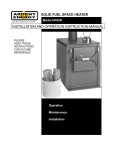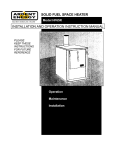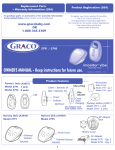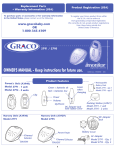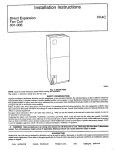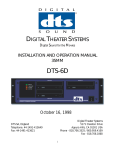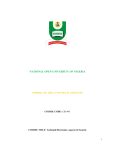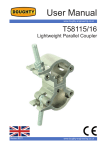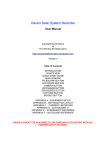Download Ardent F75R Instruction manual
Transcript
FORCED AIR WOOD FURNACE Box 3637, Smithers, BC V0J 2N0 F75R and F101 INSTALLATION AND OPERATION INSTRUCTION MANUAL PLEASE KEEP THESE INSTRUCTIONS FOR FUTURE REFERENCE Operation Maintenance Installation furnace/jc/june96 Dear Customer, You have purchased one of the finest wood burning heating systems in North America. You will find that your Ardent Energy furnace will operate much differently than the old fashioned fireboxes of the past. You will experience a new level of heating comfort and convenience, with greater control, longer burn times and reduced creosote deposits. Please take the time to become familiar with your Ardent Energy heating system. Study your manual carefully before you begin installing or operating your furnace. Keep the manual handy for future reference. If you would like to add optional equipment to your furnace, make sure that you have the serial number of your furnace when you visit your Ardent Energy dealer. This will help us give you prompt and accurate service. We at Ardent Energy congratulate you on your choice of wood furnaces, and are confident that you have purchased a product that is simply, the best. Ardent Energy Inc J G (Hans) Duerichen PEng President April 1999 (ver 3) Table of Contents 3 3 4 4 4 4 3 4 5 5 5 5 5 5 5 6 6 6 6 6 6 6 6 6 7 7 7 Safety 8 Creosote 8 Furnace Specifications OPERATION INSTRUCTIONS 9 Fuel Bypass Damper 10 Lighting 10 The First Fire 10 Wall Thermostat Operation 10 Refuelling 10 Operation if the Power Fails 11 FURNACE MAINTENANCE 12 Daily 13 As Needed 14 Ash Removal If You Have an Oil Add-on Door Draft Control Firebrick FURNACE INSTALLATION Chimney Connection Chimney Size Chimney Termination Floor Protection Duct Work Installation As A Forced Air Wood Furnace Assembly Electrical Components Installation As An Add-on to An Oil or Gas Furnace Installation As An Add-on to An Electric Furnace FURNACE OPTIONS Water Heating Coil Connecting the Coil to the Tank Draining and Cleaning When You Have No Water Paint Replacement Parts - F75R Replacement Parts - F101 Warranty furnace/jc/june96 3 Furnace Operation SAFETY WARNING: If this furnace is not properly installed, a house fire may result. For your safety, follow the installation directions. Contact local building or fire officials about restrictions and installation requirements in your area. NOTE: We strongly recommend installers to be WETT or WHERF certified. To ANYONE using this furnace: 3. DO NOT use gasoline type lantern fuel, kerosene, charcoal lighter fluid or similar liquids to start or freshen up the fire in this furnace. Keep all such liquids well away from the furnace while it is in use. 4. DO keep the furnace door shut at all times when a fire is burning. Open the door only to load or check the fire. 5. When checking or loading wood into the fire, DO pull open the bypass lever first, then open the door very slowly. 6. DO keep all combustible materials (firewood, shoes etc.) at least 18 inches away from the furnace. These DO's and DO NOT's are for your safety. 1. DO read this instruction manual before lighting your first fire. 2. DO burn seasoned wood fuel only. DO NOT burn: - driftwood (salt corrosion is not a warranty item) - treated wood - coal - garbage - plastic Also DO NOT use construction scraps (e.g., 2x4 or plywood scraps) as your only supply of fuel, as you may overheat and seriously damage the furnace. 7. Do not use a grate or elevate the fire. CREOSOTE When wood is burned slowly, it produces tar and other organic vapours, which combine with expelled moisture to form creosote. The creosote vapours condense in the relatively cool chimney flue of a slow burning fire. As a result, creosote residue accumulates in the flue lining. When ignited, this creosote makes an extremely hot fire. A chimney fire occurs when creosote in the chimney ignites, usually when the furnace is turned up high after a period of low burn. flue bypass damper smoke shield heat exchangers secondary air secondary air heat exchanger water coil water coil seal Figure 1: Furnace specifications down draft baffle cross draft angle primary air heat exchanger primary air 4 Furnace Operation The chimney should be inspected periodically during the heating season to see if a creosote build-up has occurred. If a significant layer of creosote has accumulated (1/4" or more), it should be removed to reduce the risk of chimney fire. Running the furnace at maximum with the bypass pulled out for 1 to 2 hours about once a week will minimize creosote buildup. OPERATION INSTRUCTIONS The following operating instructions must be followed carefully for satisfactory operation. FUEL In the event of an uncontrolled chimney fire, shut the bypass damper and turn down the thermostat. If the chimney fire does not die down, keep watch on the fire and prepare to vacate the house. If needed, call the fire department. NOTE: Establish a routine for the storage of fuel, care of the furnace and firing technique. Be aware that during mild weather and low furnace temperatures, more creosote is deposited and more frequent cleaning is necessary. HINT: To avoid creosote build-up especially in mild weather, fill the furnace only part way. Also, well seasoned, unchopped wood will reduce creosote build-up dramatically. BYPASS DAMPER FURNACE SPECIFICATIONS • Type of fuel • Combustion system • Temperature control • Firebox lining • Body • Doors Wood Burning Module No. Rating......(KW).. (BTU/hr). Size.........(mm)... (in.)........ Weight............... Fuel capacity.......... Max. fuel size......... Flue outlet............... Cold air inlet size..... Hot air outlet size.... - Wood, any species - Downfeed progressive crossdraft design with a constant pre-heated secondary air system - Standard wall thermostat with manual bi-metallic control during power failure - Firebrick: 1 1/4" x 4 1/2" x 9" std. - Steel: 12 ga, 10 ga & 5/16" - Constant centre push design with fibreglass rope seal F75R Fuel wood can be of any species. However, ensure that the wood is well seasoned and kept under cover. Do not burn any fuel other than wood. Please note that if you use green wood: • The amount of wood that you use will increase around 20% when using green compared to dry wood. • Heat output will be considerably lower and more frequent fuelling will be necessary. • Green wood must be cut into smaller pieces to burn acceptably. • Creosote formation may increase, especially in warm weather. • The fire will most likely have to be started with dry wood until a good bed of coals is formed. F101 `1400 - 20000 `1400 - 27000 `5000 - 75000 `5000 - 100000 710W x 965L x 1090 H 760W x 1140L x 1180H 28W x 38L x 43H 30W x 45L x 46 1/2 H 227 kg 295 kg 500 lbs 650 lbs 140 litres 250 litres 5 cu. ft. 9 cu. ft. 250 mm dia. x 500 mm long 300 mm dia. x 600 mm long 10" dia. x 20 " long 12" dia. x 24" long 178 mm dia. 203 mm dia. 7" dia. 8" dia. 305 mm x 460 mm 305 mm x 460 mm 12" x 18 " 12" x 18" 445 mm x 680 mm 625 mm x 730 mm 18" x 26 3/4" 24 1/2" x 28 3/4" When the bypass damper is open (i.e. the bypass rod is pulled out) combustion will take place within the entire firebox. Operate the furnace with the bypass damper open only when you need quick heat. • When the desired temperature has been reached, push the bypass rod in. • Whenever there is a fire burning, the bypass damper should be open for 30 seconds before you slowly open the door. • When you are starting a fire, the bypass damper should be open to vent away smoke. • The furnace door must be closed at all times, except when you are loading fuel or checking the fire. LIGHTING Light a fire in the furnace, starting with paper and kindling only. Never use any flammable liquids. After the fire is lit, leave the door open a crack for a few minutes. Once a coal bed is established, add standard cord wood and latch the door shut. THE FIRST FIRE You will experience a slow start-up during the first fire. The firebricks bricks still contain moisture and take a good hot fire to eliminate the moisture. While there is moisture in the bricks, the bricks will be black with smoke deposits. When the moisture is gone, the bricks will be light coloured. You may also experience a slight odour during the first few fires. This odour results from the curing paint and the burn-off of residual oils. 5 Furnace Operation WALLTHERMOSTAT OPERATION FURNACE MAINTENANCE Set the thermostat to the temperature desired. When the furnace is warming up a cold room, there will be an initial temperature overrun, then the temperature will stabilize. DAILY REFUELLING 1. Have wood on hand to load the firebox. 2. Open the bypass damper for 30 seconds 3. Open the door slowly. Allow the chimney to draw off smoke. 4. Load as much wood as you need (right up to the top in cold weather). 5. Close the door and push in the bypass damper. NOTE: Do not over- fire the furnace by leaving the door open. The door should be open only when you light and check the fire. Operation with the door ajar voids the warranty. OPERATION IF THE POWER FAILS (NOT FOR USE IN FURNACES WITH DOWN FLOW DUCTING) 1. Open the panel opposite to the air inlet to the wood section to allow for air circulation. 2. Open all floor registers. 3. Adjust the draft manually by pulling up the chain just below the damper motor lever, and placing it into the small damper motor lever For the first little while, check the chimney and pipe until experience shows how often cleaning is necessary. About once a week, run the furnace at maximum with the bypass open for one to two hours to burn off any creosote in the chimney and pipes. This should greatly reduce how often you will need to clean the chimney with a brush. AS NEEDED Any creosote build-up in the chimney and pipe over 6 mm (1/4") should be removed with a brush. Make sure that the bypass is open before you begin cleaning the chimney. ASH REMOVAL Ashes should be removed once they reach a depth of 100 mm (4") maximum. Let the fire burn out. Protect the area in front of the furnace with a non- combustible material. Shovel the ashes into a metal container with a tight fitting lid. Other waste should not be put in this container. The closed container of ashes should be placed outside on a non-combustible surface, or on the ground, well away from any combustible materials. If the ashes are disposed of by burial or otherwise locally dispersed, they should be retained in the closed container until you are sure that all of the cinders have thoroughly cooled. nuts pawl chain guide • To tighten the door, loosen the bottom nut and tighten the top nut Figure 3: F75R door adjustment • To adjust the door in and out, loosen the top two nuts, adjust the door. Tighten the nuts. Figure 2: Operation during a power failure slot beside the chain guide (see Figure 2) Do not expect as much heat in cold weather, because duct work is not designed for heating without a blower. When power is restored, the damper motor will automatically pull the chain off the slot and resume normal operation. • To adjust the door up or down, loosen the bottom two nuts, adjust the door. Tighten the nuts. NOTE: The chain guide must be "clipped" by installers if the furnace is installed to heat areas below the furnace. Figure 4: F101 door adjustment 6 Furnace Installation IFYOU HAVE AN OILADD-ON Operate the oil fired unit periodically to ensure that it will operate satisfactorily when you would like to use it. DOOR The door is a unique adjustable centre-push design to ensure trouble-free, air tight operation for years to come. When you close the door, there should be a slight resistance. If there is not, the door needs adjusting. The door pawl (the catch on the closing mechanism) should be lubricated regularly with a high temperature grease, so the door opens and closes easily. If the fibreglass seal shows signs of excessive wear, it may not seal properly, and cause the furnace to burn hotter than desired. Replace it with a gasket replacement kit (part # FDGRK5) DRAFT CONTROL Check that the draft control opens and closes freely. If it does not, open the front left panel and make sure the chain is not binding. FIREBRICK Take care when you are refuelling the furnace to avoid breaking the brick. If you are burning wood with chunks of ice and/or snow, do not let the frozen surfaces touch the firebrick. If any firebrick breaks, replace it immediately in order to avoid overheating the firebox. FURNACE INSTALLATION The F75R and F101 furnaces may be installed as follows: 1. As a stand-alone wood furnace with blower. 2. As an add-on to a stand-alone oil, gas or electric furnace. WARNING: These furnaces are not certified for use with an automatic stoker. CHIMNEY CONNECTION The furnace must be installed with a minimum of elbows and horizontal flue pipe. All horizontal pipe must slope towards the furnace and be installed with the seam up. The flue opening on top of the furnace is designed so the pipe will fit inside the opening. Make all connections in such a way that any condensation in the flue runs back into the furnace and not on to the floor. After installing the pipe, each joint must be secured with 3 screws spaced evenly around the joint. All single wall stove pipe must have a 460 mm (18") clearance from all unprotected combustible material. CAUTION: Under no circumstance is any type of damper or restriction to be installed in the connection between the furnace and the chimney. A barometric draft control must be installed and set at 15 PA (0.06") draft. Removal or noninstallation of the barometric damper voids the warranty. CHIMNEY SIZE F75R 178 mm (7") round or Minimum Flue Height Requirements elevation minimum flue height 0 to 2000 ft. 12 ft. 2000 to 3000 ft. 13 ft. 3000 to 4000 ft. 14 ft. 4000 to 6000 ft. 15 ft. 6000 to 8000 ft. 16 ft. 8000 to 10 000 ft. 17 ft. 150mm x 250 mm (6" x 10") inside measure F101 203 mm (8") round or 150mm x 250 mm (6" x 10") inside measure NOTE: (In U.S.A. only) You may not connect this furnace to a chimney flue serving another appliance. ARDENT Energy furnaces burn very efficiently, resulting in lower than usual flue gas temperatures. Consequently, we do not recommend an outside installation of the chimney. If you have an exterior chimney, certain weather conditions will cool the chimney below room temperature. When this happens, a back draft and/or creosote formation will occur. If you are using an existing chimney, it must be inspected carefully for soundness and to be sure that the preceding requirements are met. Note: Optimum performance for these furnaces are obtained with a draft of between 0.06" and 0.07" (Water Column). After the installation is complete, the draft must be checked by your dealer, using a draft gauge while the furnace is operating at a normal temperature. CHIMNEYTERMINATION Chimneys are required to extend at least 915 mm (3 ft.) above the highest point where they pass through the roof of the building and at least 610 mm (2 ft.) higher than any portion within 10 feet. In some cases, the chimney must be higher than the minimum for proper draft, due to unfavourable geometry of surroundings. 7 Furnace Installation FLOOR PROTECTION If the floor is combustible, it must be protected by 7 mm (9/32") or thicker of noncombustible material extending 150 mm (6") from the sides and rear, and 460 mm (18") from the front. DUCT WORK Minimum sizes: F75R Return air: 1520 sq. cm (220 sq. in) Supply air: 1290 sq. cm (200 sq. in) F101 Return air: 1610 sq. cm (250 sq. in) Supply air: 1420 sq. cm (220 sq. in) NOTE: The height of the return air inlet must not be higher than the warm air registers. A fresh air duct must be installed into the return air system (the recommended size is 8" diameter). 370 mm (14 1/2") *** Be sure to provide access for cleaning the flue pipe *** 125 mm (5") INSTALLATIONASAFORCEDAIR WOOD FURNACE Be sure that you have the following: • Wood furnace module # F75R or F101 • Blower - Delhi model 210 or Lau DUA10 • Motor - 1/3 HP, 1800 RPM, 110 V 60 Hz • Connecting duct model FCADB • Control kit model FCFC1, which includes: • Thermostat • Damper motor • Fan/limit control • Transformer c/w wiring harness Plenum pressure F75R F101 50 PA (0.20") 5 turns open 3 turns open 75 PA (0.30") 3 turns open 1 1/2 turns open 100 PA (0.40") 1 turn open 0 turns open NOTE: OBSERVE MINIMUM CLEARANCES! If you need to reduce the rear clearance, you can cut it to half (50%) if you protect combustible surfaces with .3mm (.013") or heavier sheet metal. You must space the sheet metal out 25 mm (1") by non-combustible spacers (see CSA Installation code B366 - 1791). ASSEMBLY After deciding which side is best for the blower unit, remove the inlet cover on that side. Use the screws to attach the connector. The blower sits on top of the connector, oriented so that the air moves down into the wood furnace when the blower is on. Make sure that the fan pulley is 203 mm (8") in diameter. furnace blower 150 mm (6") 25 mm (1") After measuring the pressure in the hot air plenum, set the motor pulley as follows: Figure 5a: Clearances ELECTRICAL COMPONENTS 50 mm (2") 50 mm (2"0) 25 mm (1") return air 2m (6') plenum supply duct Note: If the supply air duct is routed below furnace level (e.g., in the crawl space underneath) then the power failure mode must be deactivated (see page 4). blower connecting duct furnace Figure 5b: Duct clearances 1. Install the damper motor using the holes provided beside the control chain. 2. Install the fan/limit control bracket using the holes provided on the centre of the front of the furnace. The fan/ limit control can be installed after the hot air plenum is in place. 3. Install the junction box with the transformer on the top front corner of the furnace nearest to the blower. 4. Install the room thermostat on a wall centrally located in the home. It should be located away from the direct heat of the furnace or a hot air duct. 5. Connect the wiring as shown inFigure 6. 8 Furnace Installation damper motor wood section fan limit control wood section room thermostat wood supply air 12" x 18" connecting duct plenum 24 v white white existing oil furnace black black red wood furnace blower Figure 7: Connection to an oil furnace 120 v 3. Check the system air flow as follows: F igure 6: Wiring diagram for a forced air wood furnace INSTALLATION ASANADD-ON TOAN OIL OR GAS FURNACE Be sure that you have the following: • Wood furnace module # F75R or F101 • Control kit model FCFC2 or FCFC3, which includes: • Thermostat • Damper motor • 2 fan/limit controls mounted on a bracket • Junction box YOU MUST DETERMINE WHETHER THE OIL OR GAS FURNACE SIZE FALLS WITHIN THE RANGE SHOWN IN THE FOLLOWING TABLE: Existing t y p e F 7 5 R furnace 243 3.22 (0.85 G A S I n p u t O u t p u t to 3.79 (0.65 F 1 0 1 O I L to litres/hr 1.00USGPH) to 4.73 litres/hr to 1.25 USGPH) 20.0 to 27.8 22.2 • Find the air flow by using one of the following formulas: If you are using metric units: Q = 24 000 x G A Kw Q = air flow in cu. metres/sec G = oil input rate in litres/sec. A = air temperature rise, in °C BTU/hr) to to The temperature rise (outlet temperature minus the inlet temperature) should not exceed 30° C (85° F). If so, increase the blower speed so that the temperature rise is less than or equal to 30° C (85° F). Where: (64,000to98,000 (76,000 • Open all of the registers and install a new filter. • Measure the temperature rise using two thermometers. One should be placed through a hole in the hot air plenum. Run the furnace for 15 minutes then check the temperature, giving the thermometers enough time to read accurately. Record both the inlet and the outlet temperatures. 36.0 Kw 123,000 If you are using standard units: BTU/hr) Q = 95 000 x G A The installation must be performed in series as shown: (the attachment may be made on either side) The following checks must be carried out before making any alterations: 1. Check the size of the furnace. The furnace must match the specifications of the above table. 2. If the existing furnace is an oil furnace, then check the size of the nozzle in the oil burner (see table above). Where: Q = air flow in cu. ft/min G = oil input rate in USGPM A = air temperature rise, in °F • Check that the duct work and chimney are sound and that the chimney is of sufficient size (See the chimney section). After all checks have been carried out, the wood furnace may be installed. This task must be performed by a qualified technician. 9 Furnace Installation NOTE: The installation must comply with CAS Standard B365-M87 - "Installation Code For Solid Fuel Burning Appliances And Equipment." INSTALLATIONASANADD-ON TOAN ELECTRIC FURNACE If any changes are required on the oil furnace, these must comply with CSA Standard B139 "Installation Code for Oil Burning Equipment." Be sure that you have the following: • Wood furnace module # F75R or F101 • Control kit model FEFC3, which includes: • Thermostat • Damper motor • 2 fan/limit controls mounted on a bracket • Wiring harness with LV terminal block Prepare the plenums and connecting ducts: • The connecting duct between the oil furnace and the wood furnace must be 305 mm x 460 mm (12" x 18") with elbows having a minimum inside radius of 150 mm (6"). Your electric furnace blower must be large enough to keep the furnace equal to or below the following maximum temperature rises: • Do not connect duct work so that reverse flow is possible (the cold air return must not be higher than the warm air outlets). • After the installation is complete, recheck the air flow as before. If the air flow is less than before, the blower speed must be increased to compensate for the pressure drop through the system. • For multi-speed blower motors, use the higher speed, if needed. • For belt-driven blowers, adjust the pulley diameter on the motor to give the extra speed required. If necessary, a larger blower motor may be used if the faster speed increases the air flow above the rating on the motor nameplate. HOWEVER, THE BLOWER MUST NOT BE CHANGED. Max temp. rise, F75R °C (°F) Max temp. rise, F101 °C (°F) 10 kW 34100 24° (43°) 21° (37°) 15kW 51200 36° (65°) 31° (65°) 20 kW 68200 42° (75°) 41° (73°) 25 kW 85300 42° (75°) 42° (75°) 30 kW 102400 N/A 42° (75°) 35 kW 119400 N/A 42° (75°) WARNING: If the airflow is too low, your installation will be unsafe. NOTE: The temperature rise must be measured between the inlet and the outlet of the electric furnace only. blower limit * limit blower and wood limit - 250°F aux. limit 140° F damper motor blower (not used) wood thermostat Output (BTU/hr) If the electric furnace is certified for counter-flow operation (upside down) it should be installed according to Figure 5b. Use the connecting duct (part FCADB) in the installation. Its dimensions are shown in Figure 9. • Follow the wiring diagram precisely. oil or gas thermostat Furnace Size 432 mm (17") 16 /2 LVT 165 mm (6 1/2") 16/3 LVT black 14 /2 BX white green wire supplied with harness wire supplied by customer * jumper removed 305 mm (12") low voltage terminal block 24 V source 460 mm (18") to furnace common start relay from 24 V transformer 110 V source to blower motor Figure 9: Connecting duct (part # FJADB) Figure 8: Wiring diagram for adding on to oil or gas (control kit #FEFC2) 432 mm (17") 10 Furnace Options aux. limit 140° F blower & wood limit 250° F limit limit damper motor blower (not used) wood thermostat blower electric, oil or gas thermostat When you connect the piping to the range boiler you must strictly follow the diagram in figure 11. The two shut-off valves must be no smaller than 3/4" GATE valves. Make certain that the PRV (Watts 3L) and the P&TRV (Watts 100 XL) are installed in their respective locations and not vice versa. 16 / 3 The maximum pressure setting is 38 kPa (150 psi). Do not use less than 3/4" diameter standard pipe between the range boiler and the furnace. The orientation of the pipe must be slightly uphill from the coil outlet to the upper connection at the tank. If you do no do this, vapour lock will occur, and the water will not circulate. The minimum capacity of the range boiler should be 100 litres (26 U.S. gallons). 16 / 2 white black low voltage terminal block DRAINING AND CLEANING 16 / 4 LVT W to electric furnace relay C common from 24V transformer G to blower relay R 24 V source wire supplied with harness wire supplied by customer Cleaning should not normally be necessary unless the water tends to cause deposits. If the heating efficiency decreases noticeably, the heating coil should be inspected, and if necessary, cleaned. Figure 10: Wiring diagram for typical wood - electric combination (control kit # FEFC3) FURNACE OPTIONS WATER HEATING COIL ARDENT Energy furnaces are designed to heat your domestic hot water during the heating season. The F75R and F101 can accept 1 or two coils (1 per side). When you install the water coil (part FCSHW4) it replaces all but one of the firebricks on the side it is located. Please read all of the instructions before you begin. To install the water coil: 1. Remove the back shroud on the furnace by removing the screws. Using a good punch and hammer, punch out the two knockouts on the side where you would like to install the water coil. 2. Remove all of the firebrick from that side. 3. Punch out the two knockouts at the rear of the firebox. 4. Remove the baffle plate inside the rear of the firebox. 5. Position the water coil in the firebox, in the place where the firebrick was removed. The pipe must face the fire. 6. Install the ceramic gaskets and plates on the outside of the firebox (not on the outside of the shroud) using the provided drill and tap screws. 7. Replace the shroud. 1. Let the furnace cool down. 2. Close the valves between the range boiler and the coil. 3. Open the drain valves and drain the water from the coil. 4. Disconnect the coil at the unions. 5. Clean the coil using a drain cleaning "snake." 6. Connect the piping, close the drain and open the valves to the boiler. WHEN YOU HAVE NO WATER Do not operate your furnace with a dry water coil. The excess heat will damage the water coil. If you have no water insulate this connecting pipe P & TRV (Watts 100XL) 1/4" gate valve hot water out cold water in PRV (Watts 3L) 1/4" union dip tube furnace CONNECTING THE COILTO THE TANK range boiler (uninsulated) to drain We recommend that you use the "two tank" system. The first tank or "range boiler" must remain uninsulated to dissipate any excess heat generated by the hot water coil. Figure 11: Connection to hot water heater existing water heater to drain Furnace Options for circulation, disconnect and remove the coil. To seal the holes, use two 25 mm (1") diameter standard washers per hole, and use a 19 mm x 25 mm (3/4" x 1") bolt to hold the washers together. PAINT You may touch up the face of the furnace with STOVE BRIGHT Satin Black 1990 high temperature paint. The correct paint is available from your dealer. When you paint the face of the furnace, cover the area surrounding the furnace with newspaper. Follow the directions outlined on the spray can. DO NOT attempt to paint while the furnace is still warm. Keep the spray can away from any source of heat or open flame. Ensure that there is adequate ventilation in the room, from the time you start painting until the paint is dry. 11 12 Replacement Parts F75R Replacement Parts ITEM QTY/UNIT DESCRIPTION PART# 1 2 3 4 5 6 8 9 10 11 12 13 14 15 16 17 18 19 20 21 22 23 24 25 26 27 28 29 1 1 1 1 1 2 1 1 1 1 1 1 2 1 30" 1 1 1 2 60" 1 1 KIT 1 1 1 1 1 1 rear top shroud back shroud liner assy bypass damper assy bypass lever flame deflector outside fin water coil (optional) side shroud door bypass assembly Scandinavian baffle bypass frame bottom baffle down draft smoke shield assembly door liner cross draft angle assy side shroud assy ball chain front top shroud (T-nut) bypass bar door closure pawl hug lock nut gasket replacement kit door final assembly front side shroud prim. air heat exhanger air inlet cast butterfly "D" assembly lower front shroud A399P A414W A237W A239W A533 A407 FCSHW4 A398 A272 AAPO14 A238 A532 A129W A302 A725LW/RW A413W R6110 A400 A391 A309 R1442 FDGRK5 A317-75 A401 A390W A913 A720W A717 17 1 18 19 20 2 10 3 21 11 22 4 14 12 5 6 13 16 15 23 24 25 26 27 28 8 29 9 13 Replacement Parts 8 25 13 1 14 26 2 15 9 16 10 27 12 17 3 28 4 11 29 18 19 20 6 21 22 23 24 7 F75R & F101 FURNACE WARRANTY FIVE YEAR LIMITED WARRANTY Ardent Energy Inc warrants the F75R and F101 furnaces against defects in material and workmanship for a period of five years from the date received, with the exception of items listed hereafter in the "Exclusions" section. Ardent Energy Inc, at its option, will replace, repair or cause to be repaired any part found to be defective upon inspection by an authorized Ardent Energy Inc representative. EXCLUSIONS 1. Repairs or replacement of part or the entire appliance necessitated by use of the furnace other than for normal home use, as directed by the instruction manual. 2. Repairs or replacements necessitated by vandalism, neglect, abuse or failure to adequately service the appliance, as stated in the instruction manual. 3. Repairs or replacements necessitated by work or service not authorized by Ardent Energy Inc equipment and accessories not manufactured by Ardent Energy are warranted only to the extent of the original manufacturer’s warranty. 4. Replacement of gaskets and firebrick. 5. Repairs necessitated by excessive chimney draft. LIMITATIONS 1. All items found to be defective will be replaced or repaired upon return of the defective part to an authorized Ardent Energy Inc dealer. 2. Any furnace or part thereof that is replaced or serviced during the five year warranty period, will be warranted under the terms of that particular limited warranty for a period not exceeding the remaining term of the original limited warranty, or six months, whichever is longer. 3. This warranty is transferable. However, proof of date of purchase is required before service or replacement of any defective part is performed. 4. This Limited Warranty does not apply to damage to the furnace or part thereof, while in transit. Any claim of such must be directed to the common carrier. 5. If the installation does not conform to local building or fire codes, or in their absence, the installation requirements in the instruction manual, any claims are not valid and will not be processed. 6. Any shipping charges incurred during a warranty claim will be borne by the furnace owner. 7. The remedies set forth herein are exclusive, and the liability of Ardent Energy Inc with respect to any contract, tort, under any warranty or otherwise shall not exceed the price of the equipment or part on which such liability is based.














